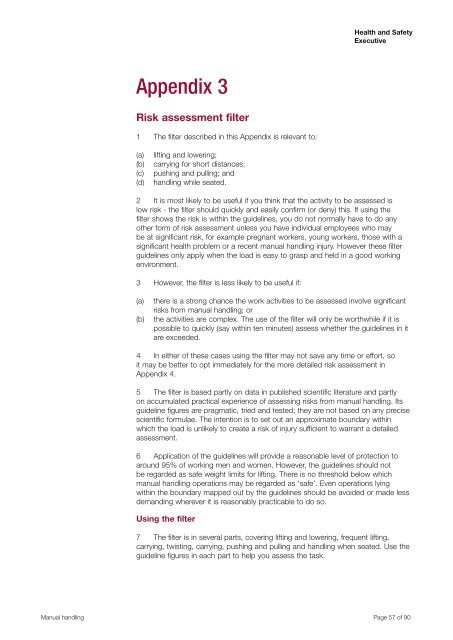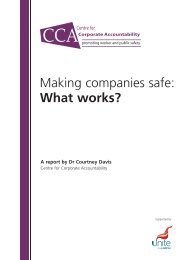Manual Handling Manual Handling Operations Regulations 1992 ...
Manual Handling Manual Handling Operations Regulations 1992 ...
Manual Handling Manual Handling Operations Regulations 1992 ...
You also want an ePaper? Increase the reach of your titles
YUMPU automatically turns print PDFs into web optimized ePapers that Google loves.
Health and Safety<br />
Executive<br />
Appendix 3<br />
Risk assessment filter<br />
1 The filter described in this Appendix is relevant to:<br />
(a)<br />
(b)<br />
(c)<br />
(d)<br />
lifting and lowering;<br />
carrying for short distances;<br />
pushing and pulling; and<br />
handling while seated.<br />
2 It is most likely to be useful if you think that the activity to be assessed is<br />
low risk - the filter should quickly and easily confirm (or deny) this. If using the<br />
filter shows the risk is within the guidelines, you do not normally have to do any<br />
other form of risk assessment unless you have individual employees who may<br />
be at significant risk, for example pregnant workers, young workers, those with a<br />
significant health problem or a recent manual handling injury. However these filter<br />
guidelines only apply when the load is easy to grasp and held in a good working<br />
environment.<br />
3 However, the filter is less likely to be useful if:<br />
(a)<br />
(b)<br />
there is a strong chance the work activities to be assessed involve significant<br />
risks from manual handling; or<br />
the activities are complex. The use of the filter will only be worthwhile if it is<br />
possible to quickly (say within ten minutes) assess whether the guidelines in it<br />
are exceeded.<br />
4 In either of these cases using the filter may not save any time or effort, so<br />
it may be better to opt immediately for the more detailed risk assessment in<br />
Appendix 4.<br />
5 The filter is based partly on data in published scientific literature and partly<br />
on accumulated practical experience of assessing risks from manual handling. Its<br />
guideline figures are pragmatic, tried and tested; they are not based on any precise<br />
scientific formulae. The intention is to set out an approximate boundary within<br />
which the load is unlikely to create a risk of injury sufficient to warrant a detailed<br />
assessment.<br />
6 Application of the guidelines will provide a reasonable level of protection to<br />
around 95% of working men and women. However, the guidelines should not<br />
be regarded as safe weight limits for lifting. There is no threshold below which<br />
manual handling operations may be regarded as ‘safe’. Even operations lying<br />
within the boundary mapped out by the guidelines should be avoided or made less<br />
demanding wherever it is reasonably practicable to do so.<br />
Using the filter<br />
7 The filter is in several parts, covering lifting and lowering, frequent lifting,<br />
carrying, twisting, carrying, pushing and pulling and handling when seated. Use the<br />
guideline figures in each part to help you assess the task.<br />
<strong>Manual</strong> handling Page 57 of 90
















